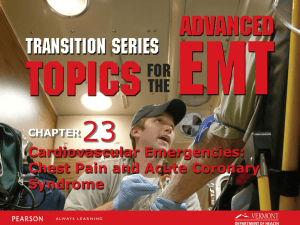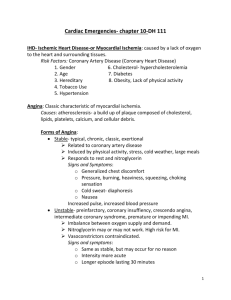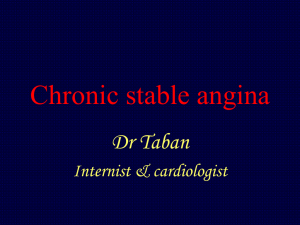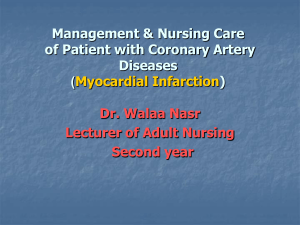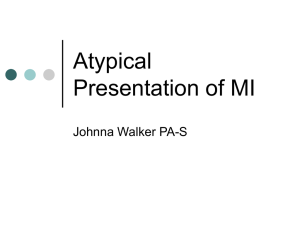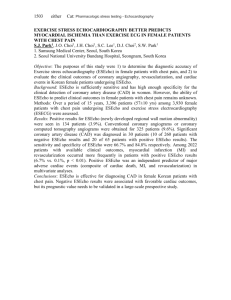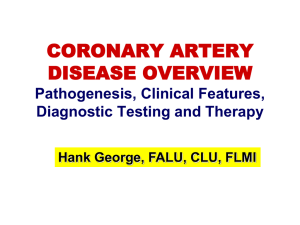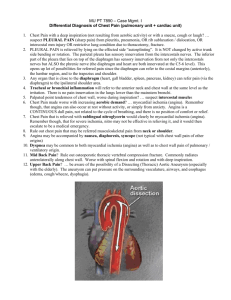File - Kelly Marchant RN
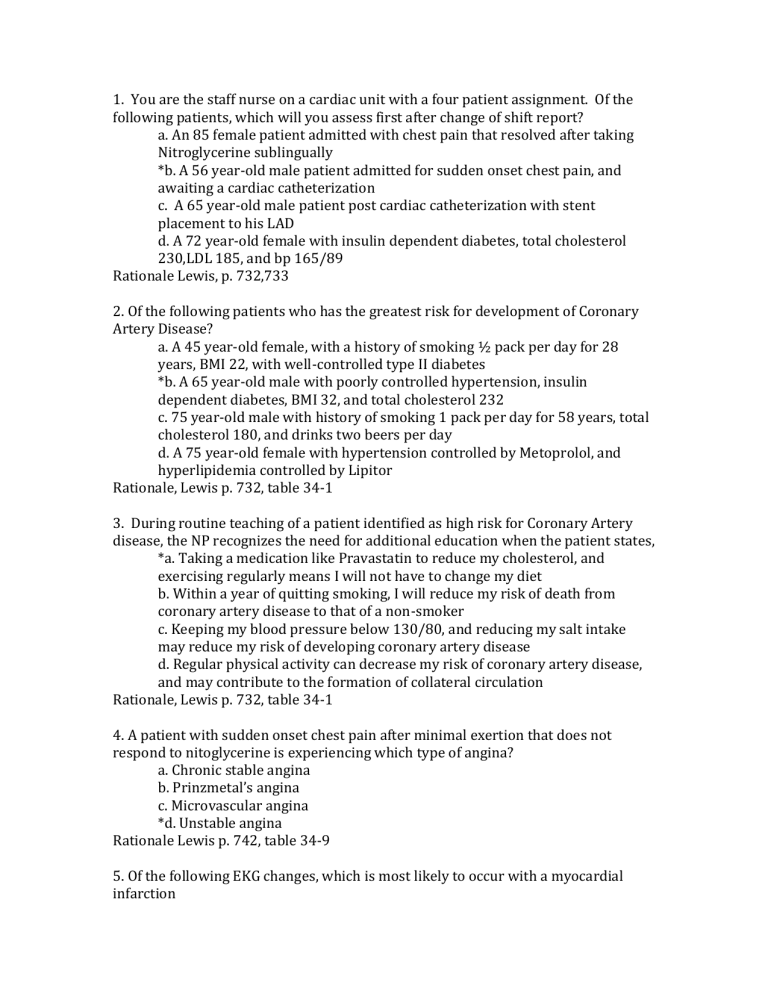
1. You are the staff nurse on a cardiac unit with a four patient assignment. Of the following patients, which will you assess first after change of shift report? a. An 85 female patient admitted with chest pain that resolved after taking
Nitroglycerine sublingually
*b. A 56 year-old male patient admitted for sudden onset chest pain, and awaiting a cardiac catheterization c. A 65 year-old male patient post cardiac catheterization with stent placement to his LAD d. A 72 year-old female with insulin dependent diabetes, total cholesterol
230,LDL 185, and bp 165/89
Rationale Lewis, p. 732,733
2. Of the following patients who has the greatest risk for development of Coronary
Artery Disease? a. A 45 year-old female, with a history of smoking ½ pack per day for 28 years, BMI 22, with well-controlled type II diabetes
*b. A 65 year-old male with poorly controlled hypertension, insulin dependent diabetes, BMI 32, and total cholesterol 232 c. 75 year-old male with history of smoking 1 pack per day for 58 years, total cholesterol 180, and drinks two beers per day d. A 75 year-old female with hypertension controlled by Metoprolol, and hyperlipidemia controlled by Lipitor
Rationale, Lewis p. 732, table 34-1
3. During routine teaching of a patient identified as high risk for Coronary Artery disease, the NP recognizes the need for additional education when the patient states,
*a. Taking a medication like Pravastatin to reduce my cholesterol, and exercising regularly means I will not have to change my diet b. Within a year of quitting smoking, I will reduce my risk of death from coronary artery disease to that of a non-smoker c. Keeping my blood pressure below 130/80, and reducing my salt intake may reduce my risk of developing coronary artery disease d. Regular physical activity can decrease my risk of coronary artery disease, and may contribute to the formation of collateral circulation
Rationale, Lewis p. 732, table 34-1
4. A patient with sudden onset chest pain after minimal exertion that does not respond to nitoglycerine is experiencing which type of angina? a. Chronic stable angina b. Prinzmetal’s angina c. Microvascular angina
*d. Unstable angina
Rationale Lewis p. 742, table 34-9
5. Of the following EKG changes, which is most likely to occur with a myocardial infarction
a. Irregular P wave b. Abbreviated PR segment
*c. Changes in ST segment d. Absent U wave
Rationale Lewis p. 749
6. Symptoms of acute coronary syndrome differ between men and women in that
*a. Initial cardiac event for women is angina; for men Acute MI b. Average age of onset is 65 for women, 70 for men c. Women have a decreased rate of fatal MI d. Risk of MI decreases after menopause
Rationale Lewis p. 733
7. A patient presents to the ED with crushing chest pain. What other symptoms would be present on physical examination in a patient experiencing an Acute MI? a. Tachycardia & Palpitations b. Nausea & Vomiting c. Dyspnea & Wheezing
*d. All of the Above
Rationale Lewis p. 747, 748
8. Of the following statements about Troponin, which is true? a. Troponin levels begin to rise about 2 hours after an MI, and peak at 3 hours
*b. Troponin levels may take as long as 14 days to return to baseline levels after an MI c. Elevated levels of troponin may indicate skeletal or cardiac muscle injury d. All of the Above
Rationale Lewis p. 749, table 34-11
9. Thrombolytic therapy for the treatment of a myocardial infarction would be contraindicated in which of the following patients? a. A patient who is actively menstruating
*b. A patient with known history of cerebral aneurysm c. A patient with controlled hypertension d. A patient with a history of internal bleeding five years ago
Rationale Lewis p. 751, table 34-13
10. The first line of treatment for patients with a confirmed myocardial infarction is
*a. Percutaneous Coronary Intervention b. Intra-aortic balloon pump therapy c. Coronary Artery Bypass Surgery d. Thrombolytic Therapy
Rationale Lewis p 751
11. A patient with known history of coronary artery disease is at greatest risk for which potential emergency a. chronic stable angina b. weight loss due to reduced activity
*c. thrombus formation leading to an myocardial infarction d. collateral circulation formation
Rationale on pt 747 Lewis
12. Myocardial ischemia differs from myocardial infarction in that a. Ischemia occurs when injury lasts longer than 20 minutes
*b. Ischemic changes are reversible when treated quickly c. In ischemia, supply of myocardial oxygen exceeds demand for oxygen d. Ischemia does not lead to permanent damage
Rationale, Lewis p. 746
13. During the care of a patient who underwent percutaneous coronary intervention for an acute myocardial infarction, which of the following activities would be appropriate to delegate to an unlicensed assistive personnel (UAP)?
*a. Frequent vital sign checks (heart rate, blood pressure, O2 saturation) b. Frequent neurovascular checks of the affected extremity c. Frequent catheter site checks to assess for hematoma or bleeding d. Frequent evaluationof pain and medication as needed
Rationale, Lewis, p 758
14. While caring for a patient experiencing chest pain, with a history of myocardial infarction, the nurse hears the patient state "Everything is happening so fast. Why are you all in such a rush?" The most appropriate response by the nurse would be a. Chest pain is a medical emergency, and in emergencies we must move quickly
*b. Chest pain requires prompt treatment in order to avoid injury and permanent damage to your heart c. Didn't they explain what was going on the last time you had chest pain? d.You need to try and relax, emotional stress can make your chest pain worse
15. During discharge teaching of a patient who underwent a percutaneous coronary intervention after experiencing an acute myocardial infarction, the nurse recognizes that education has been effective when the patient states
*a. "If I experience chest pain again I should take a nitroglycerine, if it doesn't go away in five minutes I should call 911" b. " Now that I have a stent in my heart, I will not experience chest pain again." c. "I should expect to experience chest pain frequently, and do not need to worry when I do." d. "I continue to be at risk for chest pain and another heart attack, so I should avoid physical activity."
Rationale Lewis, p. 760, table 34-17
